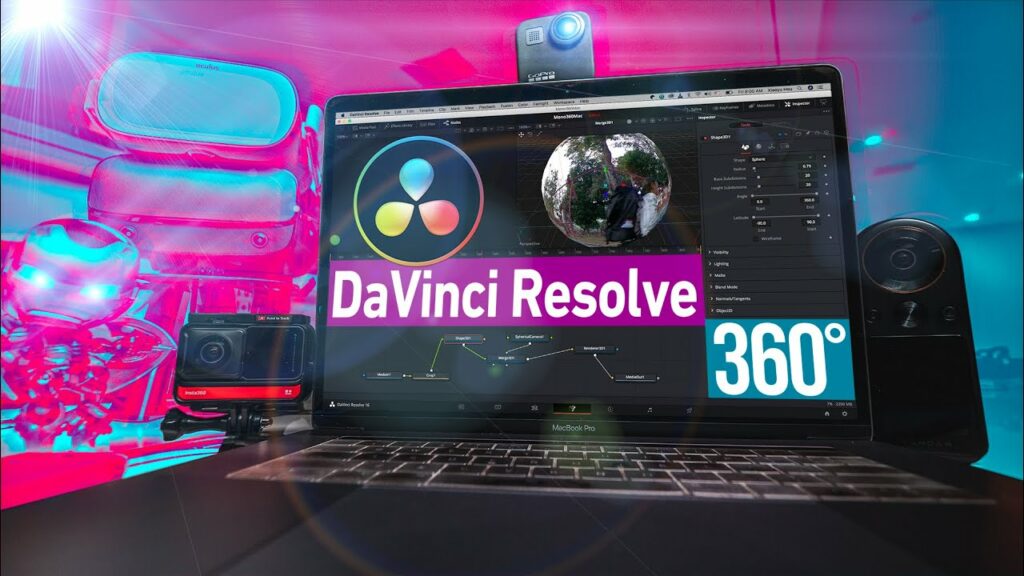Elevating Immersion: A Deep Dive into Adding 360-Degree Video Effects in DaVinci Resolve

Introduction: The realm of 360-degree video is a captivating landscape where viewers are immersed in fully interactive environments, exploring every angle and perspective. As creators venture into this realm, they seek to enhance the immersive experience through the application of dynamic and engaging visual effects. DaVinci Resolve, a comprehensive video editing and color grading software, offers a rich array of tools for adding effects to 360-degree videos with precision and creativity. In this extensive guide, we embark on a journey through the intricacies of adding effects to 360-degree videos in DaVinci Resolve, empowering creators to elevate immersion and captivate audiences with stunning visual narratives.
Understanding 360-Degree Video Effects: 360-degree video effects encompass a wide range of techniques and tools designed to enhance the visual appeal and storytelling potential of immersive content. These effects can range from basic adjustments like color correction and sharpening to more advanced techniques such as compositing, motion graphics, and visual effects. Some common types of effects applied to 360-degree videos include:
- Color Grading: Enhance the mood and atmosphere of your 360-degree videos through precise color correction, grading, and color effects. Adjust exposure, contrast, saturation, and white balance to achieve the desired look and feel.
- Stabilization: Smooth out camera motion and reduce shake and jitter in 360-degree footage to improve visual clarity and immersion.
- Motion Graphics: Add dynamic text, graphics, and animations to your 360-degree videos to convey information, guide the viewer’s attention, and enhance storytelling.
- Visual Effects: Integrate CGI elements, special effects, and compositing techniques into your 360-degree videos to create immersive and engaging visual narratives.
- Spatial Audio: Enhance the immersive experience of your 360-degree videos with spatial audio effects that simulate three-dimensional soundscapes and positional audio cues.
Adding Effects to 360-Degree Videos in DaVinci Resolve: DaVinci Resolve provides powerful tools and workflows for adding effects to 360-degree videos, enabling creators to unleash their creativity and elevate the immersive experience of their content. Follow these steps to add effects to 360-degree videos in DaVinci Resolve:
- Import Footage:
- Begin by importing your 360-degree footage into DaVinci Resolve’s media pool. Ensure that the footage is properly formatted and stitched to create a seamless spherical view.
- DaVinci Resolve supports a wide range of 360-degree video formats, including equirectangular projection and cubic map projection.
- Color Grading:
- Navigate to the Color tab in DaVinci Resolve to access the color grading tools. Select the clip you wish to color grade in the timeline.
- Use the Color Wheels, Curves, and other grading controls to adjust exposure, contrast, saturation, and color balance to achieve the desired look and feel for your 360-degree video.
- Stabilization:
- Apply stabilization to your 360-degree footage to smooth out camera motion and reduce shake and jitter. Navigate to the Color tab and apply the Stabilizer effect to the selected clip.
- Adjust the stabilization settings to achieve the desired level of smoothness and stability while preserving the immersive integrity of the spherical environment.
- Motion Graphics:
- Create dynamic text, graphics, and animations to overlay onto your 360-degree videos in DaVinci Resolve’s Fusion tab. Select the Fusion tab and create a new Fusion composition.
- Use Fusion’s node-based interface to design and animate text, graphics, and visual elements. Position and animate elements within the spherical environment to ensure they appear correctly in the final 360-degree video.
- Visual Effects:
- Integrate CGI elements, special effects, and compositing techniques into your 360-degree videos using DaVinci Resolve’s Fusion tab. Select the Fusion tab and create a new Fusion composition.
- Use Fusion’s node-based interface to composite elements seamlessly into the spherical environment, taking care to ensure proper alignment and perspective within the 360-degree space.
- Spatial Audio:
- Enhance the immersive experience of your 360-degree videos with spatial audio effects in DaVinci Resolve’s Fairlight tab. Select the Fairlight tab and import spatial audio tracks or record positional audio cues.
- Use Fairlight’s audio mixing tools to position and spatialize audio elements within the spherical environment, creating a three-dimensional soundscape that complements the visual narrative of your 360-degree video.
Best Practices for Adding Effects to 360-Degree Videos: To achieve optimal results when adding effects to 360-degree videos in DaVinci Resolve, consider the following best practices:
- Maintain Immersive Integrity: Preserve the immersive integrity of the spherical environment when adding effects, ensuring that elements are positioned and aligned correctly within the 360-degree space.
- Preview in 360-Degree Viewer: Preview the effects in DaVinci Resolve’s 360-degree viewer to assess their appearance and alignment from different perspectives within the spherical environment.
- Test Playback in VR Headsets: Verify the impact of the effects by testing playback in VR headsets or immersive platforms to simulate the viewer experience accurately.
- Experiment and Iterate: Experiment with different effects and techniques to find creative solutions that enhance the storytelling and immersion of your 360-degree videos. Iterate on your ideas to refine and optimize the final result.
- Stay Up-to-Date: Keep abreast of the latest developments and techniques in 360-degree video production to leverage new tools and workflows for adding effects in DaVinci Resolve.
Conclusion: Adding effects to 360-degree videos in DaVinci Resolve opens up a world of creative possibilities for immersive storytelling and engagement. By leveraging Resolve’s powerful tools and workflows, creators can enhance the visual appeal and immersive experience of their spherical narratives, captivating audiences and transporting them into fully interactive environments. Whether you’re color grading panoramic vistas, adding motion graphics to guide the viewer’s attention, or integrating visual effects to create immersive visual narratives, DaVinci Resolve provides the flexibility and precision to realize your creative vision and push the boundaries of immersive storytelling. Embrace the potential of 360-degree video effects and embark on a journey of immersion mastery with DaVinci Resolve.







